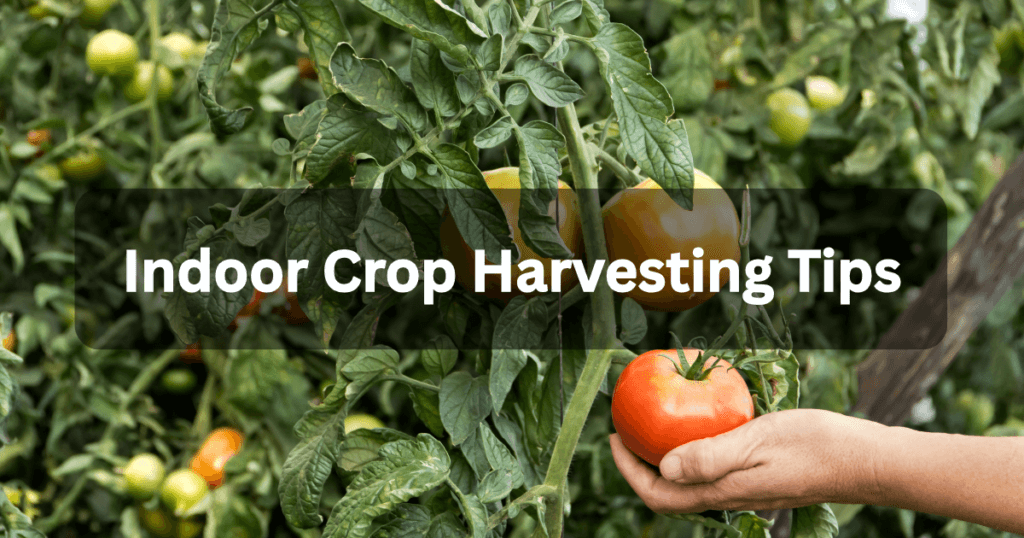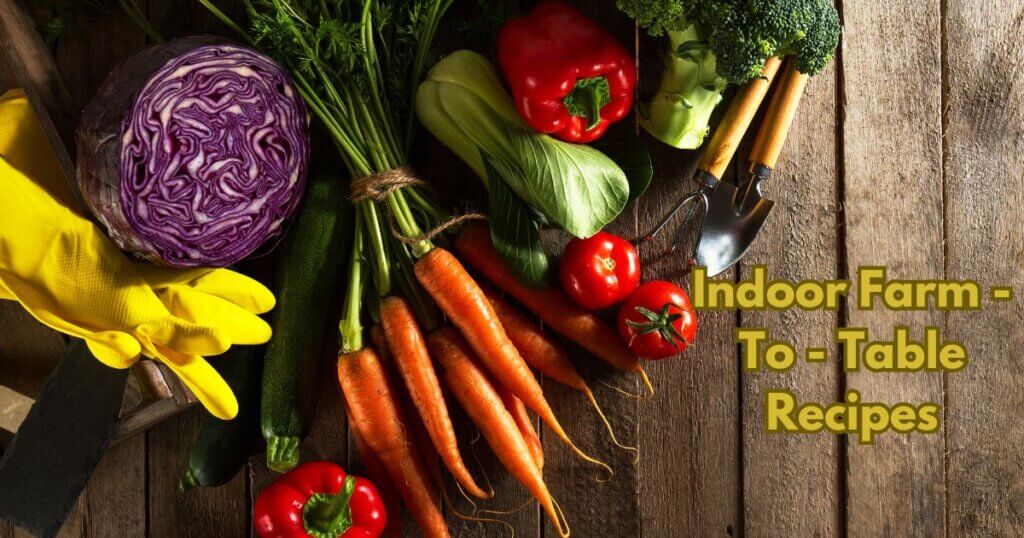10 Game-Changing Indoor Crop Harvesting Tips for Maximum Yields and Freshness

Some of the links in this post are affiliate links. As an Amazon Associate, we earn a referral fee from qualifying purchases—at no extra cost to you.
Table of Contents
Understanding the Importance of Indoor Crop Harvesting
Why Indoor Harvesting Requires Unique Techniques
Harvesting crops indoors isn’t just about picking produce. It’s an art. Controlled environments change the game completely. Unlike outdoor farming, you’re dealing with microclimates, artificial lighting, and space limitations. This makes indoor crop harvesting a precision activity. Mastering these techniques can dramatically improve freshness, flavor, and shelf life. And who doesn’t want better-tasting, longer-lasting produce?
Benefits of Harvesting Crops Indoors
Indoor harvesting offers unbeatable advantages. You avoid pests, unpredictable weather, and soil diseases. It also allows for year-round harvesting, giving you multiple harvest cycles. Best of all? It gives you control. And that control means bigger, better, and more nutritious yields when harvested right.
Key Signs Your Indoor Crops Are Ready for Harvest
Visual Indicators of Maturity
Knowing exactly when to harvest is crucial. Most crops give you visual hints—leaf color changes, fruit firmness, or the size of leaves. For example, lettuce is ready when the head feels firm, while herbs like basil are at their best just before flowering. Waiting too long can reduce taste and nutrients.
Timing Is Everything: Days to Harvest by Crop Type
Different crops follow different timelines. Lettuce takes 30-45 days. Tomatoes may need 60-85 days. Microgreens? Just 7-14 days. Understanding these timelines helps prevent premature or delayed harvesting. A calendar or journal can be your best friend here.
Essential Indoor Crop Harvesting Tips You Should Know
Tip #1: Harvest in the Morning for Optimal Freshness
Harvesting your indoor crops in the morning helps preserve their natural oils, moisture, and flavor. Plants are at their peak hydration and lowest stress levels right after dawn. This results in crisper greens, more aromatic herbs, and an overall better-quality harvest. Avoid harvesting in the heat of the day, as plants wilt quickly and lose both texture and taste.
Tip #2: Use the Right Tools to Prevent Damage
Always use sharp and clean tools such as scissors, snips, or a harvest knife when harvesting. Dull or dirty blades can tear plant tissue, which increases the risk of disease and stunts regrowth. Sanitized garden shears are simple but effective for keeping your crops in top condition. Investing in the right tools ensures your harvests are clean and your plants stay healthy and productive.
The Fiskars Micro-Tip Pruning Snips are precision tools designed for indoor gardeners. With ultra-sharp, stainless-steel blades and a comfortable grip, these snips make clean cuts that prevent damage and encourage healthy regrowth. Perfect for herbs, greens, and soft stems.
Tip #3: Be Gentle with Tender Crops
Delicate crops like leafy greens and soft herbs bruise very easily during harvesting. Always support the plant with one hand while cutting or snipping with the other to minimize damage. Treat these tender plants with the same care you’d give fragile glassware. A gentle touch keeps your produce looking fresh, helps it store longer, and improves overall quality.
Tip #4: Rotate Harvesting for Continuous Yields
Rather than harvesting everything at once, try rotating your harvests across different areas of your indoor garden. This staggered approach allows cut-and-come-again crops like spinach, arugula, and kale to regrow naturally. It keeps your plants productive for a longer period and gives you a steady supply of fresh greens. With good rotation, you’ll enjoy multiple harvests instead of just one big batch.
Tip #5: Clean Hands and Tools for Plant Health
Hygiene is crucial when harvesting indoor crops, as they are more susceptible to disease. Always wash your hands thoroughly before handling any plants to avoid spreading bacteria or pests. Disinfect your tools after each use to ensure they don’t carry harmful pathogens from one plant to another. Keeping everything clean is just like safe food prep—it protects your harvest and keeps your indoor garden thriving.
Post-Harvest Handling for Indoor Crops
Proper Washing and Drying Techniques
Immediately after harvesting, rinse your crops in cool, clean water to remove any dirt, dust, or lingering insects. This quick wash helps ensure that your produce is safe and ready for consumption or storage. Use a salad spinner to gently dry greens or pat them carefully with a clean paper towel. Excess moisture can lead to mold or spoilage, so make sure all produce is thoroughly dried before storing.
The OXO Good Grips Salad Spinner is an excellent tool for drying leafy greens and herbs without bruising. Its patented pump mechanism and non-slip base make it easy to spin excess water away gently.
Storing Your Indoor Harvest to Retain Nutrients
Proper storage is key to preserving the freshness and nutritional value of your indoor harvest. Leafy greens should be stored in perforated bags or containers in the refrigerator to maintain airflow and prevent wilting. Tomatoes are best kept at room temperature, as refrigeration can alter their texture and flavor. Herbs like basil or cilantro can be placed in jars of water, similar to fresh-cut flowers, and should always be labeled with the harvest date to track freshness.
These Rubbermaid FreshWorks Produce Saver Containers help extend the shelf life of your greens and veggies. With built-in FreshVent technology and an elevated base tray, they reduce moisture buildup and keep your harvest fresher longer.
Troubleshooting Common Indoor Harvesting Mistakes
Overharvesting and Its Impact
Overharvesting can severely weaken your plants and reduce their overall productivity. When you remove more than 30–40% of the foliage at once, the plant may struggle to recover. This kind of stress can stunt future growth or, in extreme cases, kill the plant entirely. It’s better to be patient and give your crops time to regenerate between harvests.
Underharvesting: Leaving Good Food Behind
On the other hand, delaying harvests can lead to tough textures, bitter flavors, or overly mature crops. Many plants lose their peak flavor and nutritional value if left unharvested too long. Consistent and timely picking ensures you get the best taste and texture from your produce. Make harvesting part of your regular routine so nothing goes to waste.
Harvesting Tips for Popular Indoor Crops
Leafy Greens Like Lettuce and Kale
Start by harvesting the outer leaves of the plant, leaving the inner ones intact. This method allows the plant to continue growing and producing new leaves. By only taking what you need, you extend the plant’s productivity for several weeks. Avoid pulling the whole plant unless it has reached the end of its growing cycle.
Tomatoes, Peppers, and Fruiting Crops
When harvesting fruiting crops, always use two hands—one to gently support the stem and the other to twist or cut the fruit off. This prevents damage to the plant and encourages further fruiting. Check your plants daily, as these crops ripen quickly and can become overripe in just a day or two. Harvesting at peak ripeness ensures the best flavor and texture.
Herbs Like Basil, Mint, and Cilantro
To encourage bushier, more productive plants, pinch off the top sets of leaves rather than cutting large stems. Only harvest up to one-third of the plant at a time to avoid stressing it. Regular, light harvesting helps herbs grow back fuller and healthier. With the right care, you can enjoy fresh herbs from the same plant for several months.
Boosting Future Harvests with Smart Practices
Record Keeping for Harvest Data
Keep a simple log of what you harvested, when you harvested it, and how much you collected. This running record becomes incredibly valuable over time as patterns begin to emerge. You’ll gain insights into which crops perform best, how long they take, and what conditions lead to higher yields. Think of it as creating a personalized grow manual tailored specifically to your indoor setup.
Adjusting Grow Cycles Based on Results
Use the data from your harvest records to make informed adjustments to your grow cycles. Tweak your lighting durations, nutrient schedules, and watering routines based on what has produced the best results. Each harvest gives you feedback—treat it like an experiment with lessons to apply. The more you fine-tune your process, the more efficient and productive your garden becomes.
The Dr.meter LX1330B Digital Light Meter helps you monitor light intensity in your indoor grow space. Optimize lighting schedules and make precise adjustments to improve yield and plant health.
Conclusion: Mastering Indoor Harvesting Starts Here
Indoor gardening isn’t just a hobby—it’s a lifestyle. And harvesting is where all your hard work pays off. By applying these expert indoor crop harvesting tips, you’ll enjoy tastier food, bigger yields, and a more sustainable home-growing system. Start small, stay consistent, and always keep learning from your plants. They’re the best teachers in the room.
FAQs – Indoor Crop Harvesting Tips
1. How can I tell if I’m harvesting too early or too late?
Harvesting too early can result in small, underdeveloped produce with less flavor, while waiting too long may lead to bitterness or toughness. Observe color, size, and texture based on crop type, and keep notes for future improvement.
2. What’s the best way to harvest microgreens without damaging them?
Use clean, sharp scissors to cut microgreens just above the root line. Hold the greens gently and avoid crushing them. Harvest when the first true leaves appear for peak nutrition and flavor.
3. Can I harvest and prune at the same time for better regrowth?
Yes, especially with leafy greens and herbs. Selective harvesting can double as pruning, encouraging the plant to become bushier and produce more foliage over time.
4. Is it okay to refrigerate all indoor crops right after harvest?
No, not all crops store best in the fridge. Leafy greens do well in cool temperatures, but tomatoes and some herbs like basil prefer room temperature to preserve flavor and texture.
5. How do I avoid contaminating crops during harvest?
Always wash your hands, sanitize tools, and avoid handling sick or pest-affected plants before touching healthy ones. Use gloves if needed and maintain a clean harvesting space.
Other Useful Resources Related To Indoor Crop Harvesting Tips
- Montel – Crop Rotation 2.0: How to Maximize Your Indoor Harvest
This article emphasizes the importance of thorough cleaning between harvests to prevent contamination and maintain optimal performance of indoor farming equipment. It also discusses the benefits of using antimicrobial materials in vertical farming systems.
🔗 https://www.montel.com/blog/crop-rotation-20-how-to-maximize-your-indoor-harvest - Urban Vine – The Ultimate 7 Step Guide To Indoor Growing
A comprehensive guide covering essential aspects of indoor farming, including choosing the right lighting, tools, and farming methods. It offers practical advice for beginners aiming to maximize their indoor crop yields.
🔗 https://www.urbanvine.co/blog/the-ultimate-guide-to-indoor-urban-farming-for-beginners - Eden Green – Vertical Farming: Everything You Need to Know
An informative piece that explores how vertical farming techniques can lead to increased production and consistent year-round yields, highlighting the efficiency and sustainability of indoor farming methods.
🔗 https://www.edengreen.com/blog-collection/what-is-vertical-farming - NASA Spinoff – NASA Research Launches a New Generation of Indoor Farming
This article discusses how NASA’s research into hydroponic systems and controlled environments has influenced modern indoor farming practices, leading to innovations that enhance crop yields and resource efficiency.
🔗 https://spinoff.nasa.gov/indoor-farming - Rise Gardens – Indoor Garden Crop Planning: Maximize Your Harvest Success
Offers tips on crop planning for indoor gardens, including understanding planting schedules and nutrient requirements to ensure a successful and bountiful harvest.
🔗 https://risegardens.com/blogs/communitygarden/indoor-garden-crop-planning







